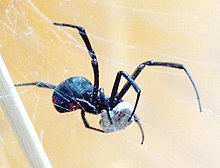Latrodectus mactans
| Latrodectus mactans | |
|---|---|
 |
|
| Scientific classification | |
| Kingdom: | Animalia |
| Phylum: | Arthropoda |
| Subphylum: | Chelicerata |
| Class: | Arachnida |
| Order: | Araneae |
| Infraorder: | Araneomorphae |
| Family: | Theridiidae |
| Genus: | Latrodectus |
| Species: | L. mactans |
| Binomial name | |
|
Latrodectus mactans (Fabricius, 1775) |
|
Latrodectus mactans, known as southern black widow or simply black widow, and the shoe-button spider, is a highly venomous species of spider in the genus Latrodectus. The females are well known for their distinctive black and red coloring and for the fact that they will occasionally eat their mate after reproduction. The species is native to North America. The venom is seldom fatal to healthy humans.
Latrodectus mactans was first described by Johan Christian Fabricius in 1775, placing it in the genus Aranea. It was transferred to the genus Latrodectus in 1837 by Charles Walckenaer and is currently placed in the Theridiidae family of the order Araneae. The species is closely related to Latrodectus hesperus (western black widow) and Latrodectus variolus (northern black widow). Members of the three species are often confused with the genus Steatoda, the false widows. Prior to 1970, when the current taxonomic divisions for North American black widows were set forth by Kaston, all three varieties were classified as a single species, L. mactans. As a result, there exist numerous references which claim that "black widow" (without any geographic modifier) applies to L. mactans alone. Common usage of the term "black widow" makes no distinction between the three species.
The body length (excluding legs) of the mature female is 8–13 mm (0.31–0.51 in), 3–6 mm (0.12–0.24 in) for males. Legs are long in proportion to body. Females are shiny and black in color, with a red marking in the shape of an hourglass on the ventral (under) side of her very rounded abdomen. There is much variation in female size, particularly in egg-carrying (gravid) females. The abdomen of a gravid female can be more than 1.25 cm (0.5 in) in diameter. Many female widows also have an orange or red patch just above the spinnerets on the top of the abdomen. Juveniles have a distinctly different appearance from the adults; the abdomen is grayish to black with white stripes running across it and is spotted with yellow and orange. Males are either purple, or closer to the appearance of the juveniles in color.
...
Wikipedia
